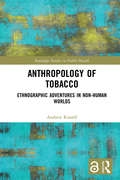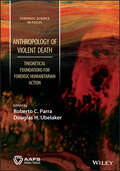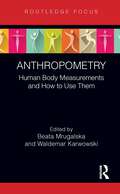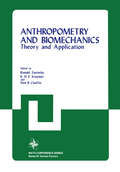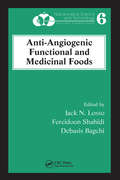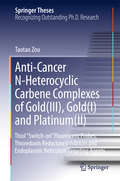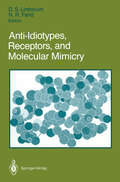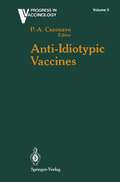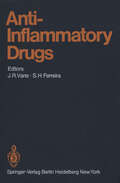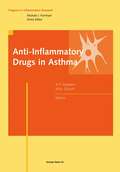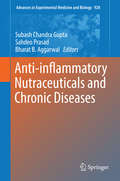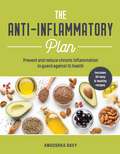- Table View
- List View
Anthropology of Nursing: Exploring Cultural Concepts in Practice
by Karen HollandThis book aims to introduce nurses and other healthcare professionals to how anthropology can help them understand nursing as a profession and as a culture. Drawing on key anthropological concepts, the book facilitates the understanding and critical consideration of nursing practice, as seen across a wide range of health care contexts, and which impacts the delivery of appropriate care for service users. Considering the fields in which nurses work, the book argues that in order for nurses to optimize their roles as deliverers of patient care, they must not only engage with the realities of the cultural world of the patient, but also that of their own multi-professional cultural environment. The only book currently in the field on anthropology of nursing, this book will be a valuable resource for nursing students at all academic levels, especially where they can pursue specific modules in the subject, as well as those other students pursuing medical anthropology courses. As well as this, it will be an essential text for those post-graduate students who wish to consider alternative world views from anthropology and their application in nursing and healthcare, in addition to their undertaking ethnographic research to explore nursing in all its fields of practice.
Anthropology of Nursing: Exploring Cultural Concepts in Practice
by Karen HollandThis book aims to introduce nurses and other healthcare professionals to how anthropology can help them understand nursing as a profession and as a culture. Drawing on key anthropological concepts, the book facilitates the understanding and critical consideration of nursing practice, as seen across a wide range of health care contexts, and which impacts the delivery of appropriate care for service users. Considering the fields in which nurses work, the book argues that in order for nurses to optimize their roles as deliverers of patient care, they must not only engage with the realities of the cultural world of the patient, but also that of their own multi-professional cultural environment. The only book currently in the field on anthropology of nursing, this book will be a valuable resource for nursing students at all academic levels, especially where they can pursue specific modules in the subject, as well as those other students pursuing medical anthropology courses. As well as this, it will be an essential text for those post-graduate students who wish to consider alternative world views from anthropology and their application in nursing and healthcare, in addition to their undertaking ethnographic research to explore nursing in all its fields of practice.
Anthropology of Tobacco [Open Access]: Ethnographic Adventures in Non-Human Worlds
by Andrew RussellTobacco has become one of the most widely used and traded commoditites on the planet. Reflecting contemporary anthropological interest in material culture studies, Anthropology of Tobacco makes the plant the centre of its own contentious, global story in which, instead of a passive commodity, tobacco becomes a powerful player in a global adventure involving people, corporations and public health. Bringing together a range of perspectives from the social and natural sciences as well as the arts and humanities, Anthropology of Tobacco weaves stories together from a range of historical, cross-cultural and literary sources and empirical research. These combine with contemporary anthropological theories of agency and cross-species relationships to offer fresh perspectives on how an apparently humble plant has progressed to world domination, and the consequences of it having done so. It also considers what needs to happen if, as some public health advocates would have it, we are seriously to imagine ‘a world without tobacco’. This book presents students, scholars and practitioners in anthropology, public health and social policy with unique and multiple perspectives on tobacco-human relations.
Anthropology of Tobacco [Open Access]: Ethnographic Adventures in Non-Human Worlds
by Andrew RussellTobacco has become one of the most widely used and traded commoditites on the planet. Reflecting contemporary anthropological interest in material culture studies, Anthropology of Tobacco makes the plant the centre of its own contentious, global story in which, instead of a passive commodity, tobacco becomes a powerful player in a global adventure involving people, corporations and public health. Bringing together a range of perspectives from the social and natural sciences as well as the arts and humanities, Anthropology of Tobacco weaves stories together from a range of historical, cross-cultural and literary sources and empirical research. These combine with contemporary anthropological theories of agency and cross-species relationships to offer fresh perspectives on how an apparently humble plant has progressed to world domination, and the consequences of it having done so. It also considers what needs to happen if, as some public health advocates would have it, we are seriously to imagine ‘a world without tobacco’. This book presents students, scholars and practitioners in anthropology, public health and social policy with unique and multiple perspectives on tobacco-human relations.
Anthropology of Violent Death: Theoretical Foundations for Forensic Humanitarian Action (Forensic Science in Focus)
by Roberto C ParraThe first book to specifically focus on the theoretical foundations of humanitarian forensic science Anthropology of Violent Death: Theoretical Foundations for Forensic Humanitarian Action consolidates the concepts and theories that are central to securing the posthumous dignity of the deceased, respecting their memories, and addressing the needs of the surviving populations affected. Focusing on the social and cultural significance of the deceased, this much-needed volume develops a theoretical framework that extends the role of humanitarian workers and specifically the actions of forensic scientists beyond an exclusively legal and technical approach. Anthropology of Violent Death is designed to inspire and alerts the scientific community, authorities, and the justice systems to think and take actions to avoid the moral injury in society and cultures due to grave disrespect against humanity, its memories and reconciliation. Humanitarian forensic science faces the role of mediator between the deceased and those who are still alive to guarantee the respect and dignity of humanity. Contributions from renowned experts address post-mortem dignity, cultural perceptions of violent death and various mortuary sites, the forms and critical effects of the so-called forensic turn and humanitarian action, the treatment of violent death in post-conflict societies, respect for the dead under International Humanitarian Law (IHL) and Islamic law, the ethical management of the death of migrants, and much more. In an increasingly violent world, this volume, develops a theoretical component for death management in scenarios where humanitarian action is required Facilities better understanding between the social sciences, the forensic sciences, and justice systems in situations involving violent death Discusses the latest theories from leading scholars and practitioners to enhance the activities of forensic scientists and authorities who have the difficult responsibility of making decisions It provides a better understanding of the humanitarian and cultural dilemmas in the face of violent death episodes, and the unresolved needs of the dignity of the deceased during armed conflicts, disasters, migration crises, including everyday homicides Anthropology of Violent Death: Theoretical Foundations for Forensic Humanitarian Action is an indispensable resource for forensic scientists, humanitarian workers, human rights defenders, and government and non-governmental officials.
Anthropology of Violent Death: Theoretical Foundations for Forensic Humanitarian Action (Forensic Science in Focus)
by Roberto C. Parra Douglas H. UbelakerThe first book to specifically focus on the theoretical foundations of humanitarian forensic science Anthropology of Violent Death: Theoretical Foundations for Forensic Humanitarian Action consolidates the concepts and theories that are central to securing the posthumous dignity of the deceased, respecting their memories, and addressing the needs of the surviving populations affected. Focusing on the social and cultural significance of the deceased, this much-needed volume develops a theoretical framework that extends the role of humanitarian workers and specifically the actions of forensic scientists beyond an exclusively legal and technical approach. Anthropology of Violent Death is designed to inspire and alerts the scientific community, authorities, and the justice systems to think and take actions to avoid the moral injury in society and cultures due to grave disrespect against humanity, its memories and reconciliation. Humanitarian forensic science faces the role of mediator between the deceased and those who are still alive to guarantee the respect and dignity of humanity. Contributions from renowned experts address post-mortem dignity, cultural perceptions of violent death and various mortuary sites, the forms and critical effects of the so-called forensic turn and humanitarian action, the treatment of violent death in post-conflict societies, respect for the dead under International Humanitarian Law (IHL) and Islamic law, the ethical management of the death of migrants, and much more. In an increasingly violent world, this volume, develops a theoretical component for death management in scenarios where humanitarian action is required Facilities better understanding between the social sciences, the forensic sciences, and justice systems in situations involving violent death Discusses the latest theories from leading scholars and practitioners to enhance the activities of forensic scientists and authorities who have the difficult responsibility of making decisions It provides a better understanding of the humanitarian and cultural dilemmas in the face of violent death episodes, and the unresolved needs of the dignity of the deceased during armed conflicts, disasters, migration crises, including everyday homicides Anthropology of Violent Death: Theoretical Foundations for Forensic Humanitarian Action is an indispensable resource for forensic scientists, humanitarian workers, human rights defenders, and government and non-governmental officials.
The Anthropology of Welfare
by Iain R. Edgar Andrew RussellThe Anthropology of Welfare provides an overview of what anthropology has to offer welfare studies and vice-versa. Case studies from anthropologists in the field, examine different branches of welfare and community care, for example: * Maternity services * Children with learning difficulties * Children's homes * Mothers' centres * People with HIV * Mental health centres * Housing * Care and provision for the elderly. Contributors focus on comparative welfare systems - examples are taken from urban and rural areas of the UK, USA, Sweden, Germany, Portugal, and New Zealand. In each case the theoretical and methodological appropriateness of social anthropology for the study of welfare, and the insights gained by bringing anthropology and welfare together are examined. The Anthropology of Welfare will be essential reading for those studying anthropology, social work and social policy and will be of interest to teachers, practitioners and researchers in applied social welfare fields.
The Anthropology of Welfare
by Iain Edgar Andrew RussellThe Anthropology of Welfare provides an overview of what anthropology has to offer welfare studies and vice-versa. Case studies from anthropologists in the field, examine different branches of welfare and community care, for example: * Maternity services * Children with learning difficulties * Children's homes * Mothers' centres * People with HIV * Mental health centres * Housing * Care and provision for the elderly. Contributors focus on comparative welfare systems - examples are taken from urban and rural areas of the UK, USA, Sweden, Germany, Portugal, and New Zealand. In each case the theoretical and methodological appropriateness of social anthropology for the study of welfare, and the insights gained by bringing anthropology and welfare together are examined. The Anthropology of Welfare will be essential reading for those studying anthropology, social work and social policy and will be of interest to teachers, practitioners and researchers in applied social welfare fields.
Anthropometry: Human Body Measurements and How to Use Them (Body of Knowledge in Human Factors and Ergonomics)
by Beata Mrugalska Waldemar KarwowskiToday, human factors and ergonomics professionals worldwide contribute to the design and evaluation of tasks, jobs, products, environments, and systems in order to make them compatible with the needs, abilities, and limitations of people. By understanding anthropometry, professionals can ensure that our home and working environments are comfortable and designed with the human in mind. This book aims to show how an understanding of anthropometrics can influence workspace design, ergonomics in the office, ergonomics in the home, and health and safety at work. This book discusses the measurement of the human body and human variability. Anthropometry may seem to be relatively simple but the reality is that it focuses on very sophisticated aspects of how to make the products tailor-made to suit specific requirements. As a study, it is useful for a variety of purposes such as workspace design, ergonomics in the office, ergonomics in the home, and health and safety at work. These eleven chapters investigate anthropometrics and bridge the gap between theory and practice. Each chapter is supported by tables, charts, and illustrations, and a wide list of bibliographic references. The reader will develop new insights into the principles and practice of anthropometrics with this book bringing the topic right up to date. Anthropometry: Human Body Measurements and How to Use Them will be of interest to students, graduates, teachers, researchers, and general workers in industrial design, ergonomics, rehabilitation, safety, and health.
Anthropometry: Human Body Measurements and How to Use Them (Body of Knowledge in Human Factors and Ergonomics)
by Beata Mrugalska Waldemar KarwowskiToday, human factors and ergonomics professionals worldwide contribute to the design and evaluation of tasks, jobs, products, environments, and systems in order to make them compatible with the needs, abilities, and limitations of people. By understanding anthropometry, professionals can ensure that our home and working environments are comfortable and designed with the human in mind. This book aims to show how an understanding of anthropometrics can influence workspace design, ergonomics in the office, ergonomics in the home, and health and safety at work. This book discusses the measurement of the human body and human variability. Anthropometry may seem to be relatively simple but the reality is that it focuses on very sophisticated aspects of how to make the products tailor-made to suit specific requirements. As a study, it is useful for a variety of purposes such as workspace design, ergonomics in the office, ergonomics in the home, and health and safety at work. These eleven chapters investigate anthropometrics and bridge the gap between theory and practice. Each chapter is supported by tables, charts, and illustrations, and a wide list of bibliographic references. The reader will develop new insights into the principles and practice of anthropometrics with this book bringing the topic right up to date. Anthropometry: Human Body Measurements and How to Use Them will be of interest to students, graduates, teachers, researchers, and general workers in industrial design, ergonomics, rehabilitation, safety, and health.
Anthropometry and Biomechanics: Theory and Application (Nato Conference Series #16)
by Ronald EasterbyAssessment of the physical dimensions of the human body and application of this knowledge to the design of tools, equip ment, and work are certainly among the oldest arts and sciences. It would be an easy task if all anthropometric dimensions, of all people, would follow a general rule. Thus, philosophers and artists embedded their ideas about the most aesthetic proportions into ideal schemes of perfect proportions. "Golden sections" were developed in ancient India, China, Egypt, and Greece, and more recently by Leonardo DaVinci, or Albrecht Durer. However, such canons are fictive since actual human dimensions and proportions vary greatly among individuals. The different physical appearances often have been associated with mental, physiological and behavioral characteristics of the individuals. Hypocrates (about 460-377 BC) taught that there are four temperaments (actually, body fluids) represented by four body types. The psychiatrist Ernst Kretchmer (1888-1964) proposed that three typical somatotypes (pyknic, athletic, aesthenic) could reflect human character traits. Since the 1940's, W. H. Sheldon and his coworkers devised a system of three body physiques (endo-, meso-, ectomorphic). The classification was originally qualitative, and only recently has been developed to include actual measurements.
Anti-Aging: Von der Antike zur Moderne
by Ralph M. TrüebDieses Buch verfolgt den Weg der Altenheilkunde zur modernen Praxis der Anti-Aging-Medizin von der Antike bis in die Moderne, wie sie sich aus dem geschichtlichen Kontext entwickelt hat. Psychologische Beiträge beleuchten die Auseinandersetzung mit dem Alter auch aus psychologischer Sicht. Speziell der unbedingte Wunsch nicht nur unserer modernen Gesellschaft, Jugendlichkeit und Schönheit bis ins hohe Alter zu bewahren. "Bei voller Gesundheit sah ich meine Urenkel in vierter Generation, und so genoss ich zur Genüge mein hohes Alter" (Spätbabylonische Keilinschrift)
Anti-Angiogenic Functional and Medicinal Foods
by Jack N. Losso Fereidoon Shahidi Debasis BagchiThe ability to regulate and manipulate the generation or remodeling of blood vessels is key to the successful treatment of many chronic diseases, both oncological and non-oncological. Several bioactive compounds present in human diets are now known to exert an inhibitive effect on the either the signaling or construction of new blood vessels. The i
Anti-Angiogenic Therapy in Ophthalmology (Essentials in Ophthalmology)
by Andreas StahlThis book provides a concise overview over the pathology of retinal angiogenic diseases and explains why anti-angiogenic therapy is effective in so many patients. The reader is guided through the various clinical indications for anti-angiogenic therapy and made aware of its merits as well as current challenges and limitations. It is explained how, since its introduction for the treatment of exudative age-related macular degeneration in 2006, anti-angiogenic therapy has revolutionized the way in which we treat a range of ocular diseases. All of the authors are established experts in their respective fields who share their extensive knowledge and clinical experience with the reader. This book is both a valuable introduction to anti-angiogenic therapy in ophthalmology and a day-to-day companion for all ophthalmologists seeing patients with some of the most prevalent retinal diseases.
Anti-Cancer N-Heterocyclic Carbene Complexes of Gold: Thiol “Switch-on” Fluorescent Probes, Thioredoxin Reductase Inhibitors and Endoplasmic Reticulum Targeting Agents (Springer Theses)
by Taotao ZouThis thesis focuses on the development of gold- and non-classical platinum-based anti-cancer agents that display distinctively different anti-cancer mechanisms compared to the commonly used cisplatin. These metal complexes contain N-heterocyclic carbene (NHC) ligands which are able to form strong M-C(NHC) bonds, conferring high stability and favorable lipophilicity, reactivity and binding specificity of metal complexes on biomolecules. The author demonstrates significant advances made in anti-cancer gold(III), gold(I) and platinum(II) complexes. Detailed chemical synthesis, in vitro and/or in vivo anti-cancer activities are clearly presented including: (i) a class of Au(III) complexes containing a highly fluorescent N^N^N ligand and NHC ligand that simultaneously act as fluorescent thiol “switch-on” probes and anti-cancer agents; (ii) a dinuclear gold(I) complex with a mixed diphosphine and bis(NHC) ligand displaying favorable stability and showing significant inhibition of tumor growth in two independent mice models with no observable side effects; and (iii) a panel of stable luminescent cyclometalated platinum(II) complexes exhibiting high specificity to localize to the endoplasmic reticulum (ER) domain, inducing ER stress and cell apoptosis. These works highlight the clinical potential that gold and platinum complexes offer for cancer treatment.
Anti-diabetes and Anti-obesity Medicinal Plants and Phytochemicals: Safety, Efficacy, and Action Mechanisms
by Bashar Saad Hilal Zaid Siba Shanak Sleman KadanThis work presents a systematic review of traditional herbal medicine and their active compounds, as well as their mechanism of action in the prevention and treatment of diabetes and obesity. The side effects and safety of herbal-derived anti-diabetic and anti-obesity phytochemicals are detailed in depth, and the text has a strong focus on current and future trends in anti-diabetic medicinal plants. This unique and comprehensive text is the only current book on the market focusing exclusively on medicinal plants used to combat obesity and diabetes. An introductory chapter focuses on diabetes and obesity and introduces the major causes and main treatments of this increasing epidemic in modern society. Readers are then introduced to medicinal plants, including details on their therapeutic aspects, plus side effects and safety. Following chapters focus on anti-diabetic and anti-obesity medicinal plants, as well as phytogenic natural products in the treatment of each. The text closes by focusing on present and future trends and challenges in these medicinal plants. Anti-diabetes and Anti-obesity Medicinal Plants and Phytochemicals: Safety, Efficacy, and Action Mechanisms is a much-needed and truly original work, finally presenting in one place all the necessary information on medicinal plants used in conjunction with obesity and diabetes prevention.
Anti-Discriminatory Practice: Equality, Diversity and Social Justice (Practical Social Work Series)
by Neil ThompsonAddressing the common concepts and issues across the various forms of discrimination, this core text from one of Palgrave’s best-selling authors explores the reasons why the development of anti-discriminatory practice is so vital and examines the steps that need to be taken towards constructing a social work practice based on principles of anti-discrimination and the promotion of equality. This is key reading for undergraduate and postgraduate modules on Anti-discriminatory and Anti-oppressive Practice modules on Social Work programmes, as well as Social Work Theory and Social Work Practice modules. Practitioners will also benefit hugely from the experience and expertise of Neil Thompson.
Anti-discriminatory Practice in Mental Health Care for Older People
by Siobhan Spencer Rena Kydd-Williams Rachel Tribe Peter Cockersell Pauline Lane Musthafar Oladosu Matt Broadway-Horner Maria Castro Romero Ajit ShahExploring the key issues around anti-discriminatory practice for professionals working in mental health services, this book looks at ways to improve the health and social care of older people from minority and excluded communities. The chapters explore the issues involved in working with individuals from a range of minority groups, such as LGBT people, people with learning disabilities, people from black and minority ethnic communities, homeless people and people with dementia. The chapters cover important theory and research into discrimination, ageing and identity. Contributions from experts in the fields of mental health and working with minority groups provide practical insights into developing anti-discriminatory practice.There is also practical advice on culturally appropriate support for carers, cultural competency in end of life care, working with interpreters, and celebrating diversity, accompanied by supporting practical resources. This comprehensive book will provide mental health practitioners and students with an essential understanding of anti-discriminatory practice.
Anti-discriminatory Practice in Mental Health Care for Older People (PDF)
by Afreen Huq Ajit Shah Maria Castro Romero Matt Broadway-Horner Maureen Mcintosh Musthafar Oladosu Pauline Lane Peter Cockersell Rachel Tribe Rena Kydd-Williams Siobhan SpencerExploring the key issues around anti-discriminatory practice for professionals working in mental health services, this book looks at ways to improve the health and social care of older people from minority and excluded communities. The chapters explore the issues involved in working with individuals from a range of minority groups, such as LGBT people, people with learning disabilities, people from black and minority ethnic communities, homeless people and people with dementia. The chapters cover important theory and research into discrimination, ageing and identity. Contributions from experts in the fields of mental health and working with minority groups provide practical insights into developing anti-discriminatory practice.There is also practical advice on culturally appropriate support for carers, cultural competency in end of life care, working with interpreters, and celebrating diversity, accompanied by supporting practical resources. This comprehensive book will provide mental health practitioners and students with an essential understanding of anti-discriminatory practice.
Anti-Idiotypes, Receptors, and Molecular Mimicry
by Nadir R. Farid D. ScottLinthicumHere is an up-to-date review of important new methods and results in anti-idiotypes, receptors, and molecular mimicry. It begins with a discussion of the theoretical background of the anti-idiotypic network, it's role in the regulation of immune response, and the physical characteristics of anti-idiotypic antibodies. It then goes on to explore many exciting applications in such areas as insulin action, thyroid cell function, the neurosciences, cardiology, virology, pharmacology, and reproduction.
Anti-Idiotypic Vaccines (Progress in Vaccinology #3)
by Pierre-Andre CazenaveVaccines have historically been considered to be the most cost-effective method for preventing communicable diseases. It was a vaccine~hat enabled global eradication of the dreaded disease smallpox. Mass immunization of children forms the anchor of the strategy of the World Health Organization (WHO) to attain "health for all" status by the year 2000. Vaccinology is undergoing a dimensional change with the advances that have taken place in immunology and genetic engineering. Vaccines that confer short or inadequate immunity or that have side effects are being replaced by better vaccines. New vaccines are being developed for a variety of maladies. Monoclonal antibodies and T cell clones have been employed to delineate the immunodeterminants on microbes, an approach elegantly complemented by computer graphics and molecular imaging techniques. Possibilities have opened for obtaining hitherto scarce antigens of parasites by the DNA recombinant route. Better appreciation of the idiotypic network has aroused research on anti-idiotypic vaccines. Solid-phase synthesis of peptides is leading to an array of synthetic vaccines, an approach that is expected to attain its full potential once the sequences activating suppressor cells are discovered and the rules for presentation of antigens to T and B cells are better worked out. A new breed of vaccines is on the horizon that seeks to control fertility.
Anti-Inflammatory Drugs (Handbook of Experimental Pharmacology #50 / 2)
by C.G. van ArmanWith contributions by numerous experts
Anti-Inflammatory Drugs in Asthma (Progress in Inflammation Research)
by Martin K. Church Anthony P. SampsonFor some years, international guidelines on the management of asthma have stressed the importance of early intervention with anti-inflammatory drugs to prevent acute asthma exacerbations and to avert chronic inflammatory damage to the airway. Introduced by a broad survey of the targets for anti-inflammatory drugs, this book proceeds to bring together the most recent research into the mechanisms and clinical benefits of presently available anti-inflammatory treatments including corticosteroids, cromones, and theophylline. For the first time, these drugs are discussed alongside the newly introduced leukotriene modifier drugs, and in the context of frontline research into anti-inflammatory drugs of the future. Leading authorities in their fields evaluate the prospects of novel anti-IgE agents and cytokine antagonists, and examine recent developments in immunosuppressant compounds, protease inhibitors, and selective phosphodiesterase inhibitors. This book is an up-to-date and authoritative survey which will be invaluable to university and pharmaceutical company researchers working on anti-asthma and anti-allergy drugs and to respiratory physicians keeping abreast of developments in their specialty.
Anti-inflammatory Nutraceuticals and Chronic Diseases (Advances in Experimental Medicine and Biology #928)
by Subash Chandra Gupta Sahdeo Prasad Bharat B. AggarwalThis comprehensive volume focuses on anti-inflammatory nutraceuticals and their role in various chronic diseases. Food and Drug Administration (FDA) approved drugs such as steroids, non-steroidal anti-inflammatory drugs (NSAIDS), statins and metformin have been shown to modulate inflammatory pathways, but their long-term intake has been associated with numerous side effects. This means that there is enormous potential for dietary agents that can modulate inflammatory pathways in humans. Leading experts describe the latest research on the role of anti-inflammatory nutraceuticals in preventing and treating chronic diseases.
The Anti-inflammatory Plan: Prevent and Reduce Chronic Inflammation to Guard Against Ill Health
by Anoushka DavyInflammation is a normal and essential part of the body's defence system. It signals that damage is present and that the rest of the immune system needs to kick into action. However, when it becomes chronic, steps need to be taken to heal inflammation-related problems.Divided into four parts, The Anti-inflammation Plan guides the reader through the science behind inflammation and how it affects the body; ways of reducing it by getting enough sleep and reducing stress; the essential ingredients and nutrients needed such as green leafy vegetables, tomatoes and turmeric. The final part of the book offers 30 easy and delicious recipes making this book a comprehensive plan for reducing inflammation in the body.

